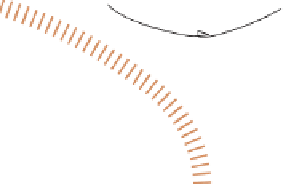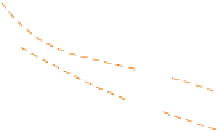Geoscience Reference
In-Depth Information
effects, or secondary geochemical reworking of litho-
sphere and mantle. Indeed, the notion that subduction
zones are destructive margins is only partially correct. It
is not the original oceanic lithosphere which is recycled
but a version altered by hydrothermal reaction with sea
water on its emplacement, together with sea water itself,
ocean sedi-ments and fragments of adjacent continental
crust and asthenosphere. It perpetuates fractionation
processes and is responsible for a wide range of construc-
tive materials which form new continental crust, tectonic
landforms such as mountain belts and the majority of
surface volcanoes.
Subduction proceeds by the displacement of litho-
sphere with negative buoyancy, acquired by densifica-
tion and cooling, down a plane inclined away from the
direction of spreading oceanic lithosphere. Known as
the
Wadati-Benioff
or, commonly,
Benioff
or
B-subduction
zone, it promotes deep seismic activity. Descending slab
is heated by conduction, on contact with hotter litho-
sphere, and friction in the narrow seismic zone. It
undergoes
metamorphism
or physico-chemical alteration
and eventually melts, at a depth set by the thermal and
pressure environment of the subduction zone and its
own thickness and geochemistry. Melting would occur
at greater depths than at constructive margins, since
the critical 1,400
of peridotite in adjacent continental asthenosphere. Sub-
duction eventually ceases when thermal equilibrium is
reached with the surrounding mantle at depths of
600-700 km. By then it has created the most unstable and
complicated global surface architecture of marine basins,
volcanoes and mountains (
Figure 10.9
).
Volcanic island arcs and ocean trenches
A glance at an atlas shows that most island systems form
curved 'necklaces' strung out towards ocean margins. An
almost continuous string in the western Pacific extends
from the Aleutian Islands of Alaska, south through the
Kuril Islands, Japan, the Marianas, the Solomon Islands,
the New Hebrides, Samoa and Tonga to New Zealand.
Branches also extend through the Philippines and
Indonesia into the Indian Ocean. Evocative names of
volcanoes such as Krakatoa (erupted 1883), Tambora
(erupted 1815), Pinatubo (erupted 1991) and Fuji are
associated with these islands arcs. Together, they form
the western half of the circum-Pacific volcano-seismic
'Ring of Fire'. Volcanic island arcs also occur where the
smaller Caribbean and Scotia plates oppose the westward-
spreading Atlantic Ocean, forming the Antilles arc
(including Mount Pelée, erupted 1902, and Soufrière Hills,
erupted 1995) and Scotia arc respectively. A small arc
through southern Greece and Italy marks the residual
thrust of the African plate into Europe. Here the Santorini
eruption probably ended the Bronze Age Minoan
civilization of ancient Crete
c
. 1625
BC
, Vesuvius destroyed
Pompeii in
AD
79 and, in 1980, Etna entered a new and
continuing active phase.
C isotherm may be drawn down over
200 km below the surface by the cold, descending slab.
However, contamination by surface materials reduces the
initial melting temperature to less than 650°C. Ocean-
wetted basaltic lithosphere, in particular, begins to melt
at only 80 km and the water driven off aids the melting
OCEAN
BASIN
VOLCANIC
ARC
FORE-ARC
BACK-ARC
CONTINENT
TRENCH
Compression zone - crustal shortening
Extension zone - crustal extension
Eruptive volcanism
Effusive volcanism
Ocean
r
o
n-g
ubd
Trench
suction
Back-arc
convection
High pressure
metamorphism
(blue schist zone)
Melt
0
100
Zone of fractional melting
and earthquakes
Upwelling
magma
Partial melt
km

































































































































